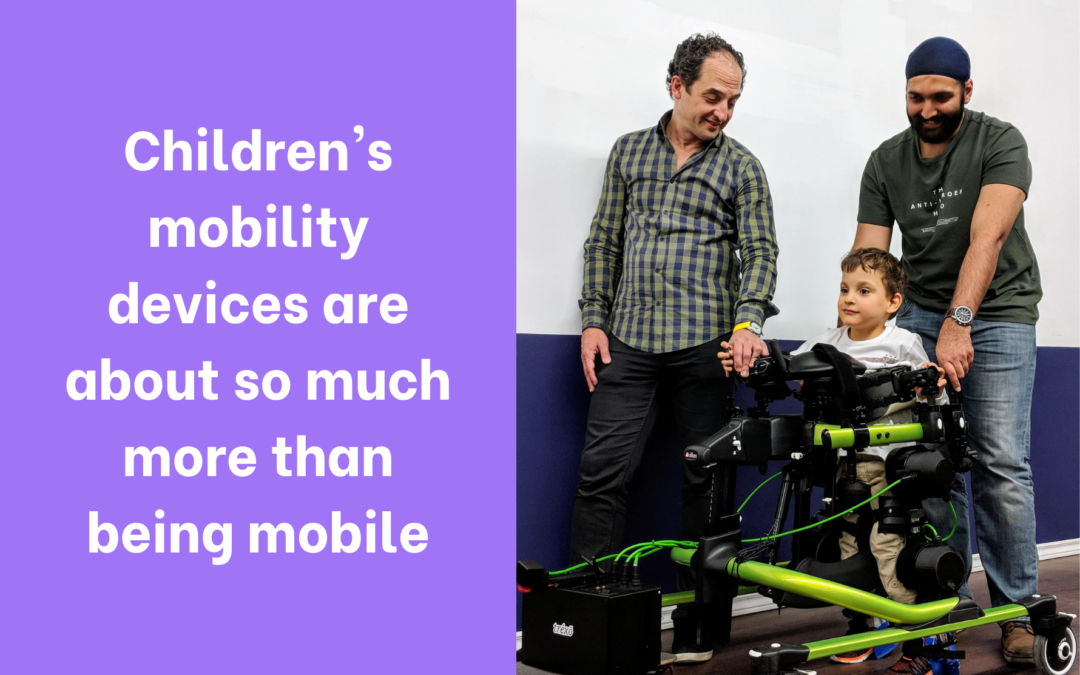When we first started working on a solution to help children learn to walk, we considered existing state-of-the-art assisive technologies in the field. In looking at emerging technologies such as exoskeletons, we were surprised to see that while there were a growing number of devices for adults, there weren’t any for children. We quickly realized that it is because you can’t simply take an adult technology, shrink it in size and expect it to work for children. Fundamentally, it comes down to the different needs of individuals with congenital vs. acquired conditions.
Before one can walk, they must learn to walk
All children, regardless of ability, need to learn how to walk. Children learn to walk despite it initially being less efficient than crawling and falling being common. Before a child is ready to walk, they need to develop their bones and muscles to support them. Eventually the child can learn how to stand and practice balance. With balance comes cruising that over time turns to walking. The Baby Center provides a good summary of walking milestones.
Walking in itself is not very intuitive though. An article in Discover Magazine once described walking as “a series of controlled falls”. Apparently research out of the Movement Lab at Ohio State University studied walking and found that with each stride we fall and correct to stay stable.
Overtime and with enough practice, this repetitive motion should become one you don’t give much thought to. In essence, you learn to walk through practice and repetition.
What happens then when someone cannot practice walking regularly? If a step in the learning process is missed, it may hinder the learning and pose a challenge later.
Limitation of current assistive technologies
As we thought about this issue more, we realized that we were trying to solve the wrong problem. The problem we’re trying to address is not “what kind of assistive device can power the legs to help a child walk?”, rather “how do you help a child learn to walk using assistive technology?”
Most adults who use an exoskeleton have walked at some point before. They may need a device like an exoskeleton because of an acquired injury such as a stroke. An exoskeleton for these individuals can be a very powerful rehabilitation device and mobility tool while they try to regain their walking ability. Just like this man who recently crossed a finish line after an accident damaged his spine.
Most children living with a physical disability, on the other hand, have not fully developed their capability to walk. They haven’t practiced walking for hundreds of hours to build their muscle memory of the motion. Young children also have bones and muscles that are still developing. In many cases this means they may not be able to support their weight independently or have a hard time with balance.
Now imagine wearing an exoskeleton as a child who has not yet learned how to walk: you must balance yourself in this piece of equipment while also learning how to shift your balance, try not to fall and somehow move forward. It just doesn’t work.
So then what kind of technology can teach walking?
Child development occurs very quickly and simultaneously. As a child is growing, they learn many skills by participating in everyday activities and interacting with their environments. Walking provides an opportunity to build independence, explore surroundings, and perform new activities. It is also important for the maintenance of one’s health.
As a result, children need assistive technologies that are safe, comfortable, and fun. Gait trainers such as the Rifton Pacer are wonderful for these purposes and aid many individuals in their daily mobility. Sometimes though, they’re not enough. The user may need more guidance to learn how to walk correctly. Or they may need assistance to take them from taking a few steps to hundreds of steps so that they can get enough practice. These are the problems we’re solving.
Our approach at Trexo
We have been learning how to make our assistive technology better by working directly with kids. Although we learned a lot, we know there is a lot more to be done. We’re continuing to work with physiotherapists, doctors and parents to further improve. Some features we have recently been adding to the Trexo Plus are:
- Comfortable support to ensure a child can focus on what their legs are doing instead of worrying about having an unpleasant experience.
- Child-friendly straps to help them get in and out of the device easily, without causing pain and irritation during the session.
- Ensuring familiarity through the use of existing devices so that exercise isn’t a stressful and overwhelming activity.
Altogether we’re excited about working with children in supporting them to become empowered and active individuals. Walking, after all, is a basic mobility right that we should all have the option to use.
Interested in the Trexo Home?
See what Jo-Anne Weltman, PT and owner of Smile Therapy for Kids thinks of the Trexo. Looking to read about kids’ experiences? Check out Leo’s and Praneit’s stories of walking with the Trexo!
The Trexo Home is available for pre-order now! If you would like to learn more, fill out the contact form below and we will get in touch!


Recent Comments